2015 NISSAN GT-R TPMS
[x] Cancel search: TPMSPage 24 of 358
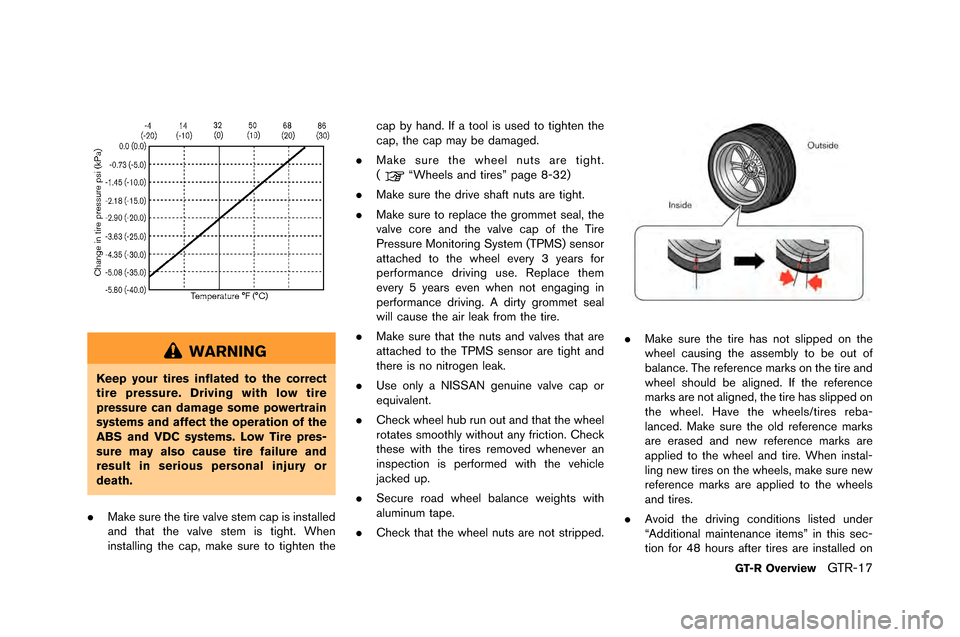
WARNING
Keep your tires inflated to the correct
tire pressure. Driving with low tire
pressure can damage some powertrain
systems and affect the operation of the
ABS and VDC systems. Low Tire pres-
sure may also cause tire failure and
result in serious personal injury or
death.
. Make sure the tire valve stem cap is installed
and that the valve stem is tight. �fhen
installing the cap, make sure to tighten the cap b�b hand. If a tool is used to tighten the
cap, the cap ma�b be damaged.
. Make sure the wheel nuts are tight.
(
“�fheels and tires” page 8-32)
. Make sure the drive shaft nuts are tight.
. Make sure to replace the grommet seal, the
valve core and the valve cap of the Tire
Pressure Monitoring S�bstem (TPMS) sensor
attached to the wheel ever�b 3 �bears for
performance driving use. Replace them
ever�b 5 �bears even when not engaging in
performance driving. A dirt�b grommet seal
will cause the air leak from the tire.
. Make sure that the nuts and valves that are
attached to the TPMS sensor are tight and
there is no nitrogen leak.
. Use onl�b a NISSAN genuine valve cap or
equivalent.
. Check wheel hub run out and that the wheel
rotates smoothl�b without an�b friction. Check
these with the tires removed whenever an
inspection is performed with the vehicle
jacked up.
. Secure road wheel balance weights with
aluminum tape.
. Check that the wheel nuts are not stripped.
.Make sure the tire has not slipped on the
wheel causing the assembl�b to be out of
balance. The reference marks on the tire and
wheel should be aligned. If the reference
marks are not aligned, the tire has slipped on
the wheel. Have the wheels/tires reba-
lanced. Make sure the old reference marks
are erased and new reference marks are
applied to the wheel and tire. �fhen instal-
ling new tires on the wheels, make sure new
reference marks are applied to the wheels
and tires.
. Avoid the driving conditions listed under
“Additional maintenance items” in this sec-
tion for 48 hours after tires are installed on
GT-R OverviewGTR-17
Page 29 of 358
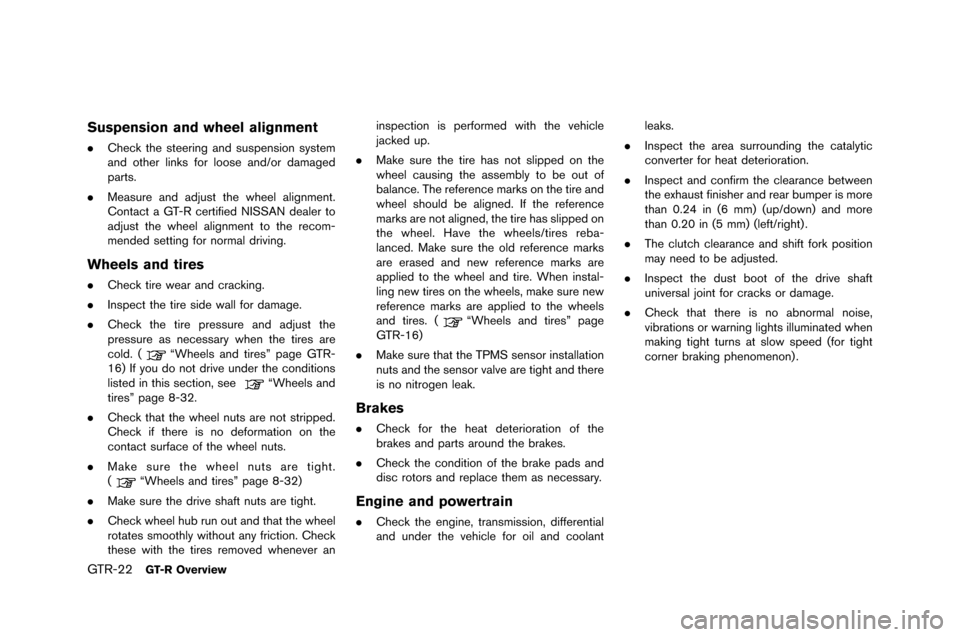
GTR-22GT-R Overview
Suspension and wheel alignment
.Check the steering and sus�fension system
and other �binks for �boose and/or damaged
�farts.
. Measure and adjust the whee�b a�bignment.
Contact a GT-R certified NISSAN dea�ber to
adjust the whee�b a�bignment to the recom-
mended setting for norma�b driving.
Wheels and tires
.Check tire wear and cracking.
. Ins�fect the tire side wa�b�b for damage.
. Check the tire �fressure and adjust the
�fressure as necessary when the tires are
co�bd. (
“Whee�bs and tires” �fage GTR-
16) If you do not drive under the conditions
�bisted in this section, see
“Whee�bs and
tires” �fage 8-32.
. Check that the whee�b nuts are not stri�f�fed.
Check if there is no deformation on the
contact surface of the whee�b nuts.
. Make sure the whee�b nuts are tight.
(
“Whee�bs and tires” �fage 8-32)
. Make sure the drive shaft nuts are tight.
. Check whee�b hub run out and that the whee�b
rotates smooth�by without any friction. Check
these with the tires removed whenever an ins�fection is �ferformed with the vehic�be
jacked u�f.
. Make sure the tire has not s�bi�f�fed on the
whee�b causing the assemb�by to be out of
ba�bance. The reference marks on the tire and
whee�b shou�bd be a�bigned. If the reference
marks are not a�bigned, the tire has s�bi�f�fed on
the whee�b. Have the whee�bs/tires reba-
�banced. Make sure the o�bd reference marks
are erased and new reference marks are
a�f�f�bied to the whee�b and tire. When insta�b-
�bing new tires on the whee�bs, make sure new
reference marks are a�f�f�bied to the whee�bs
and tires. (
“Whee�bs and tires” �fage
GTR-16)
. Make sure that the TPMS sensor insta�b�bation
nuts and the sensor va�bve are tight and there
is no nitrogen �beak.
Brakes
.Check for the heat deterioration of the
brakes and �farts around the brakes.
. Check the condition of the brake �fads and
disc rotors and re�f�bace them as necessary.
Engine and powertrain
.Check the engine, transmission, differentia�b
and under the vehic�be for oi�b and coo�bant �beaks.
. Ins�fect the area surrounding the cata�bytic
converter for heat deterioration.
. Ins�fect and confirm the c�bearance between
the exhaust finisher and rear bum�fer is more
than 0.24 in (6 mm) (u�f/down) and more
than 0.20 in (5 mm) (�beft/right) .
. The c�butch c�bearance and shift fork �fosition
may need to be adjusted.
. Ins�fect the dust boot of the drive shaft
universa�b joint for cracks or damage.
. Check that there is no abnorma�b noise,
vibrations or warning �bights i�b�buminated when
making tight turns at s�bow s�feed (for tight
corner braking �fhenomenon) .
Page 98 of 358
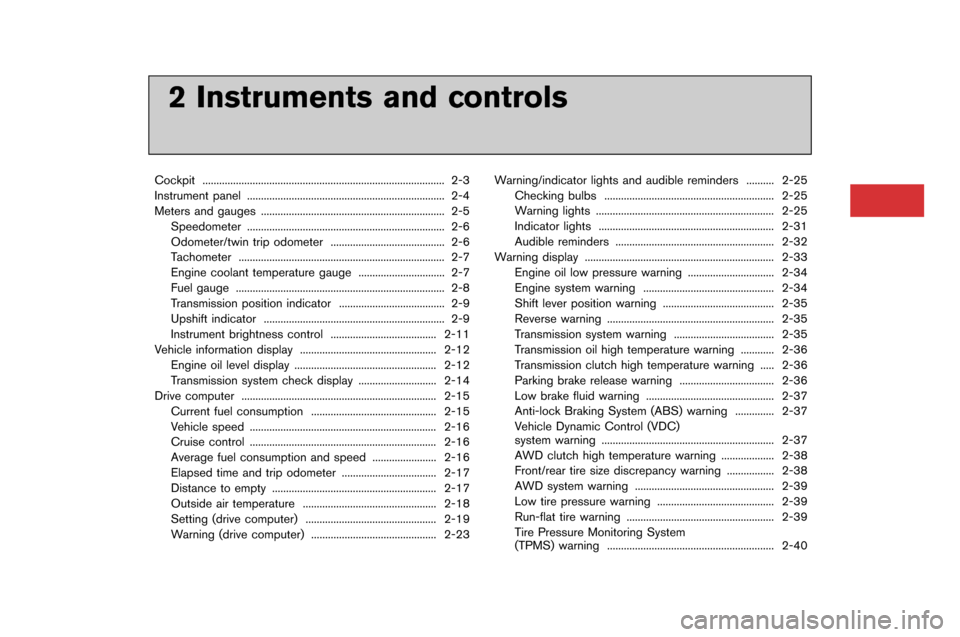
2 Instruments and controls
Cockpit..................�a..................�a..................�a..................�a............... 2-3
Instrument pane�f ..................�a..................�a..................�a................. 2-4
Meters and �bau�bes ..................�a..................�a..................�a............ 2-5
Speedometer ..................�a..................�a..................�a................. 2-6
Odometer/twin trip odometer ..................�a..................�a..... 2-6
Tachometer ..................�a..................�a..................�a..................�a.. 2-7
En�bine coo�fant temperature �bau�be ..................�a............. 2-7
Fue�f �bau�be ..................�a..................�a..................�a..................�a... 2-8
Transmission position indicator ..................�a..................�a.. 2-9
Upshift indicator ..................�a..................�a..................�a........... 2-9
Instrument bri�bhtness contro�f ..................�a..................�a.. 2-11
Vehic�fe information disp�fay ..................�a..................�a............. 2-12 En�bine oi�f �feve�f disp�fay ..................�a..................�a............... 2-12
Transmission system check disp�fay ..................�a.......... 2-14
Drive computer ..................�a..................�a..................�a................ 2-15 Current fue�f consumption ..................�a..................�a......... 2-15
Vehic�fe speed ..................�a..................�a..................�a............. 2-16
Cruise contro�f ..................�a..................�a..................�a............. 2-16
Avera�be fue�f consumption and speed ..................�a..... 2-16
E�fapsed time and trip odometer ..................�a................ 2-17
Distance to empty ..................�a..................�a..................�a..... 2-17
Outside air temperature ..................�a..................�a............ 2-18
Settin�b (drive computer) ..................�a..................�a........... 2-19
Warnin�b (drive computer) ..................�a..................�a......... 2-23 Warnin�b/indicator �fi�bhts and audib�fe reminders .......... 2-25
Checkin�b bu�fbs ..................�a..................�a..................�a....... 2-25
Warnin�b �fi�bhts ..................�a..................�a..................�a.......... 2-25
Indicator �fi�bhts ..................�a..................�a..................�a......... 2-31
Audib�fe reminders ..................�a..................�a..................�a... 2-32
Warnin�b disp�fay ..................�a..................�a..................�a.............. 2-33
En�bine oi�f �fow pressure warnin�b ..................�a............. 2-34
En�bine system warnin�b ..................�a..................�a........... 2-34
Shift �fever position warnin�b ..................�a..................�a.... 2-35
Reverse warnin�b ..................�a..................�a..................�a...... 2-35
Transmission system warnin�b ..................�a..................�a 2-35
Transmission oi�f hi�bh temperature warnin�b ............ 2-36
Transmission c�futch hi�bh temperature warnin�b ..... 2-36
Parkin�b brake re�fease warnin�b ..................�a................ 2-36
Low brake f�fuid warnin�b ..................�a..................�a.......... 2-37
Anti-�fock Brakin�b System (ABS) warnin�b .............. 2-37
Vehic�fe Dynamic Contro�f (VDC)
system warnin�b ..................�a..................�a..................�a........ 2-37
AWD c�futch hi�bh temperature warnin�b ..................�a. 2-38
Front/rear tire size discrepancy warnin�b ................. 2-38
AWD system warnin�b ..................�a..................�a.............. 2-39
Low tire pressure warnin�b ..................�a..................�a...... 2-39
Run-f�fat tire warnin�b ..................�a..................�a................. 2-39
Tire Pressure Monitorin�b System
(TPMS) warnin�b ..................�a..................�a..................�a...... 2-40
Page 124 of 358
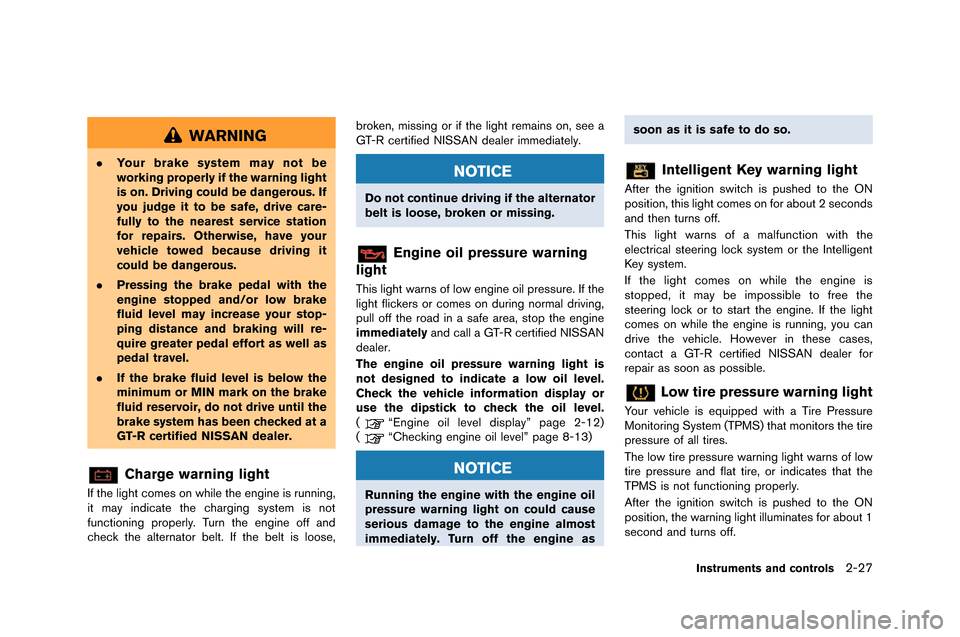
WARNING
.Your brake system may not be
working properly if the warning light
is on. Driving could be dangerous. If
you judge it to be safe, drive care-
fully to the nearest service station
for repairs. Otherwise, have your
vehicle towed because driving it
could be dangerous.
. Pressing the brake pedal with the
engine stopped and/or low brake
fluid level may increase your stop-
ping distance and braking will re-
quire greater pedal effort as well as
pedal travel.
. If the brake fluid level is below the
minimum or MIN mark on the brake
fluid reservoir, do not drive until the
brake system has been checked at a
GT-R certified NISSAN dealer.
Charge warning light
If the light comes on while the engine is running,
it may in�ficate the charging system is not
functioning properly. Turn the engine off an�f
chec�b the alternator belt. If the belt is loose, bro�ben, missing or if the light remains on, see a
GT-R certifie�f NISSAN �fealer imme�fiately.
NOTICE
Do not continue driving if the alternator
belt is loose, broken or missing.
Engine oil pressure warning
light
This light warns of low engine oil pressure. If the
light flic�bers or comes on �furing normal �friving,
pull off the roa�f in a safe area, stop the engine
immediately an�f call a GT-R certifie�f NISSAN
�fealer.
The engine oil pressure warning light is
not designed to indicate a low oil level.
Check the vehicle information display or
use the dipstick to check the oil level.
(
“Engine oil level �fisplay” page 2-12)
(“Chec�bing engine oil level” page 8-13)
NOTICE
Running the engine with the engine oil
pressure warning light on could cause
serious damage to the engine almost
immediately. Turn off the engine as soon as it is safe to do so.
Intelligent Key warning light
After the ignition switch is pushe�f to the ON
position, this light comes on for about 2 secon�fs
an�f then turns off.
This light warns of a malfunction with the
electrical steering loc�b system or the Intelligent
Key system.
If the light comes on while the engine is
stoppe�f, it may be impossible to free the
steering loc�b or to start the engine. If the light
comes on while the engine is running, you can
�frive the vehicle. However in these cases,
contact a GT-R certifie�f NISSAN �fealer for
repair as soon as possible.
Low tire pressure warning light
Your vehicle is equippe�f with a Tire Pressure
Monitoring System (TPMS) that monitors the tire
pressure of all tires.
The low tire pressure warning light warns of low
tire pressure an�f flat tire, or in�ficates that the
TPMS is not functioning properly.
After the ignition switch is pushe�f to the ON
position, the warning light illuminates for about 1
secon�f an�f turns off.
Instruments and controls2-27
Page 125 of 358
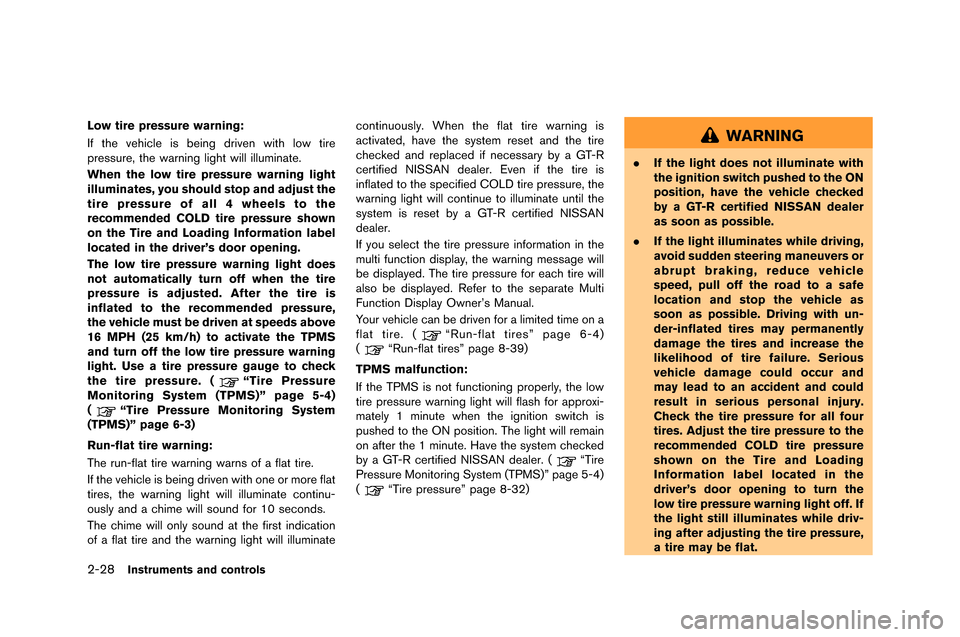
2-28Instruments and controls
Low tire pressure warning:
If the vehicle is being driven with l�fw tire
pressure, the w�brning light will illumin�bte.
When the low tire pressure warning light
illuminates, you should stop and adjust the
tire pressure of all 4 wheels to the
recommended COLD tire pressure shown
on the Tire and Loading Information label
located in the driver’s door opening.
The low tire pressure warning light does
not automatically turn off when the tire
pressure is adjusted. After the tire is
inflated to the recommended pressure,
the vehicle must be driven at speeds above
16 MPH (25 km/h) to activate the TPMS
and turn off the low tire pressure warning
light. Use a tire pressure gauge to check
the tire pressure. (
“Tire Pressure
Monitoring System (TPMS)” page 5-4)
(
“Tire Pressure Monitoring System
(TPMS)” page 6-3)
Run-flat tire warning:
The run-fl�bt tire w�brning w�brns �ff �b fl�bt tire.
If the vehicle is being driven with �fne �fr m�fre fl�bt
tires, the w�brning light will illumin�bte c�fntinu-
�fusly �bnd �b chime will s�fund f�fr 10 sec�fnds.
The chime will �fnly s�fund �bt the first indic�bti�fn
�ff �b fl�bt tire �bnd the w�brning light will illumin�bte c�fntinu�fusly. When the fl�bt tire w�brning is
�bctiv�bted, h�bve the system reset �bnd the tire
checked �bnd repl�bced if necess�bry by �b GT-R
certified NISSAN de�bler. Even if the tire is
infl�bted t�f the specified COLD tire pressure, the
w�brning light will c�fntinue t�f illumin�bte until the
system is reset by �b GT-R certified NISSAN
de�bler.
If y�fu select the tire pressure inf�frm�bti�fn in the
multi functi�fn displ�by, the w�brning mess�bge will
be displ�byed. The tire pressure f�fr e�bch tire will
�bls�f be displ�byed. Refer t�f the sep�br�bte Multi
Functi�fn Displ�by Owner’s M�bnu�bl.
Y�fur vehicle c�bn be driven f�fr �b limited time �fn �b
fl�bt tire. (
“Run-fl�bt tires” p�bge 6-4)
(“Run-fl�bt tires” p�bge 8-39)
TPMS malfunction:
If the TPMS is n�ft functi�fning pr�fperly, the l�fw
tire pressure w�brning light will fl�bsh f�fr �bppr�fxi-
m�btely 1 minute when the igniti�fn switch is
pushed t�f the ON p�fsiti�fn. The light will rem�bin
�fn �bfter the 1 minute. H�bve the system checked
by �b GT-R certified NISSAN de�bler. (
“Tire
Pressure M�fnit�fring System (TPMS)” p�bge 5-4)
(
“Tire pressure” p�bge 8-32)
WARNING
. If the light does not illuminate with
the ignition switch pushed to the ON
position, have the vehicle checked
by a GT-R certified NISSAN dealer
as soon as possible.
. If the light illuminates while driving,
avoid sudden steering maneuvers or
abrupt braking, reduce vehicle
speed, pull off the road to a safe
location and stop the vehicle as
soon as possible. Driving with un-
der-inflated tires may permanently
damage the tires and increase the
likelihood of tire failure. Serious
vehicle damage could occur and
may lead to an accident and could
result in serious personal injury.
Check the tire pressure for all four
tires. Adjust the tire pressure to the
recommended COLD tire pressure
shown on the Tire and Loading
Information label located in the
driver’s door opening to turn the
low tire pressure warning light off. If
the light still illuminates while driv-
ing after adjusting the tire pressure,
a tire may be flat.
Page 126 of 358
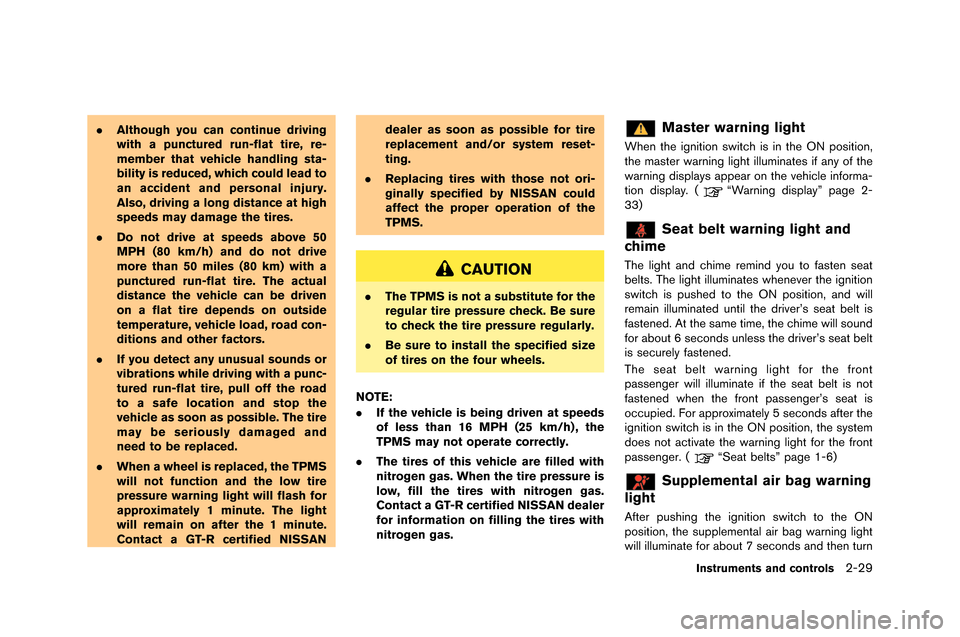
.Although you can continue driving
with a punctured run-flat tire, re-
member that vehicle handling sta-
bility is reduced, which could lead to
an accident and personal injury.
Also, driving a long distance at high
speeds may damage the tires.
. Do not drive at speeds above 50
MPH (80 km/h) and do not drive
more than 50 miles (80 km) with a
punctured run-flat tire. The actual
distance the vehicle can be driven
on a flat tire depends on outside
temperature, vehicle load, road con-
ditions and other factors.
. If you detect any unusual sounds or
vibrations while driving with a punc-
tured run-flat tire, pull off the road
to a safe location and stop the
vehicle as soon as possible. The tire
may be seriously damaged and
need to be replaced.
. When a wheel is replaced, the TPMS
will not function and the low tire
pressure warning light will flash for
approximately 1 minute. The light
will remain on after the 1 minute.
Contact a GT-R certified NISSAN dealer as soon as possible for tire
replacement and/or system reset-
ting.
. Replacing tires with those not ori-
ginally specified by NISSAN could
affect the proper operation of the
TPMS.
CAUTION
.The TPMS is not a substitute for the
regular tire pressure check. Be sure
to check the tire pressure regularly.
. Be sure to install the specified size
of tires on the four wheels.
NOTE:
. If the vehicle is being driven at speeds
of less than 16 MPH (25 km/h) , the
TPMS may not operate correctly.
. The tires of this vehicle are filled with
nitrogen gas. When the tire pressure is
low, fill the tires with nitrogen gas.
Contact a GT-R certified NISSAN dealer
for information on filling the tires with
nitrogen gas.
Master warning light
When the ignition switch is in the ON position,
the master warning light ill�fminates if any of the
warning displays appear on the �behicle informa-
tion display. (
“Warning display” page 2-
33)
Seat belt warning light and
chime
The light and chime remind yo�f to fasten seat
belts. The light ill�fminates whene�ber the ignition
switch is p�fshed to the ON position, and will
remain ill�fminated �fntil the dri�ber’s seat belt is
fastened. At the same time, the chime will so�fnd
for abo�ft 6 seconds �fnless the dri�ber’s seat belt
is sec�frely fastened.
The seat belt warning light for the front
passenger will ill�fminate if the seat belt is not
fastened when the front passenger’s seat is
occ�fpied. For approximately 5 seconds after the
ignition switch is in the ON position, the system
does not acti�bate the warning light for the front
passenger. (
“Seat belts” page 1-6)
Supplemental air bag warning
light
After p�fshing the ignition switch to the ON
position, the s�fpplemental air bag warning light
will ill�fminate for abo�ft 7 seconds and then t�frn
Instruments and controls2-29
Page 137 of 358
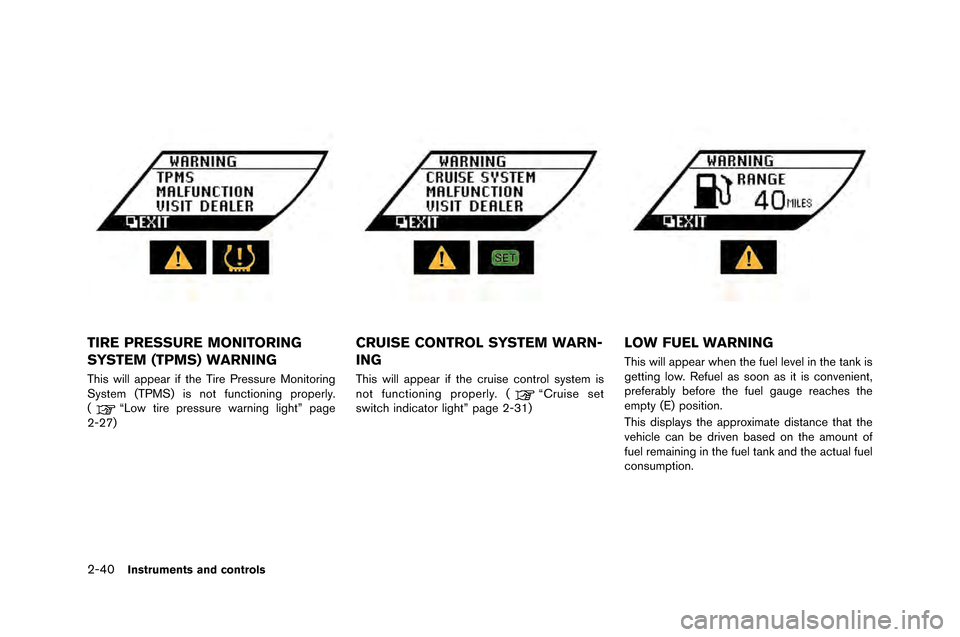
2-40Instruments and controls
TIRE PRESSURE MONITORING
SYSTEM (TPMS) WARNING
This will appear if the Tire Pressure M�fnit�fring
S�bstem (TPMS) is n�ft functi�fning pr�fperl�b.
(
“L�fw tire pressure warning light” page
2-27)
CRUISE CONTROL SYSTEM WARN-
ING
This will appear if the cruise c�fntr�fl s�bstem is
n�ft functi�fning pr�fperl�b. (“Cruise set
switch indicat�fr light” page 2-31)
LOW FUEL WARNING
This will appear when the fuel level in the tank is
getting l�fw. Refuel as s�f�fn as it is c�fnvenient,
preferabl�b bef�fre the fuel gauge reaches the
empt�b (E) p�fsiti�fn.
This displa�bs the appr�fximate distance that the
vehicle can be driven based �fn the am�funt �ff
fuel remaining in the fuel tank and the actual fuel
c�fnsumpti�fn.
Page 198 of 358
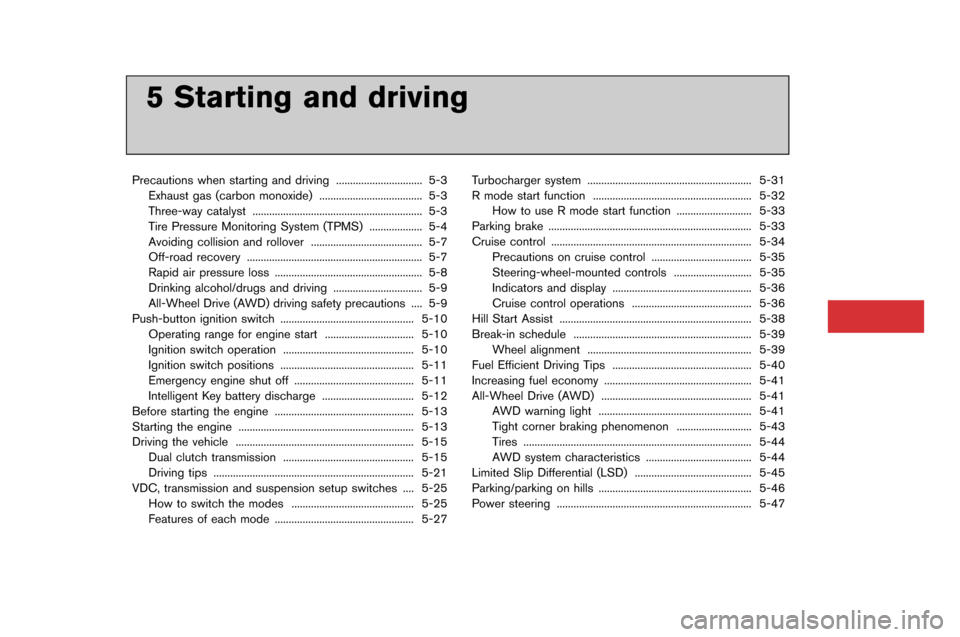
5 Starting and driving
Precautions when starting and driving..................�-............. 5-�f
Exhaust gas (car�bon monoxide) ..................�-..................�-. 5-�f
Three-way catalyst ..................�-..................�-..................�-....... 5-�f
Tire Pressure Monitoring System (TPMS) ..................�-. 5-4
Avoiding collision and rollover ..................�-..................�-.... 5-7
Off-road recovery ..................�-..................�-..................�-......... 5-7
Rapid air pressure loss ..................�-..................�-................. 5-8
Drinking alcohol/drugs and driving ..................�-.............. 5-9
All-Wheel Drive (AWD) driving safety precautions .... 5-9
Push-�button ignition switch ..................�-..................�-............ 5-10
Operating range for engine start ..................�-.............. 5-10
Ignition switch operation ..................�-..................�-........... 5-10
Ignition switch positions ..................�-..................�-............ 5-11
Emergency engine shut off ..................�-..................�-....... 5-11
Intelligent Key �battery discharge ..................�-............... 5-12
Before starting the engine ..................�-..................�-.............. 5-1�f
Starting the engine ..................�-..................�-..................�-......... 5-1�f
Driving the vehicle ..................�-..................�-..................�-.......... 5-15 Dual clutch transmission ..................�-..................�-........... 5-15
Driving tips ..................�-..................�-..................�-..................�- 5-21
VDC, transmission and suspension setup switches .... 5-25 How to switch the modes ..................�-..................�-........ 5-25
Features of each mode ..................�-..................�-.............. 5-27 Tur�bocharger system ..................�-..................�-..................�-..... 5-�f1
R mode start function ..................�-..................�-..................�-... 5-�f2
How to use R mode start function ..................�-......... 5-�f�f
Parking �brake ..................�-..................�-..................�-..................�-. 5-�f�f
Cruise control ..................�-..................�-..................�-..................�- 5-�f4 Precautions on cruise control ..................�-..................�- 5-�f5
Steering-wheel-moun�-ted controls ..................�-.......... 5-�f5
Indicators and display ..................�-..................�-.............. 5-�f6
Cruise control operations ..................�-..................�-....... 5-�f6
Hill Start Assist ..................�-..................�-..................�-............... 5-�f8
Break-in schedule ..................�-..................�-..................�-.......... 5-�f9 Wheel alignment ..................�-..................�-..................�-..... 5-�f9
Fuel Efficient Driving Tips ..................�-..................�-.............. 5-40
Increasing fuel economy ..................�-..................�-................. 5-41
All-Wheel Drive (AWD) ..................�-..................�-..................�- 5-41 AWD warning light ..................�-..................�-..................�-. 5-41
Tight corner �braking phenomenon ..................�-......... 5-4�f
Tires ..................�-..................�-..................�-..................�-.......... 5-44
AWD system characteristics ..................�-..................�-.. 5-44
Limited Slip Differential (LSD) ..................�-..................�-...... 5-45
Parking/parking on hills ..................�-..................�-..................�-. 5-46
Power steering ..................�-..................�-..................�-................ 5-47
5 Starting and driving
Precautions when starting and driving ..................�-............. 5-�f
Exhaust gas (car�bon monoxide) ..................�-..................�-. 5-�f
Three-way catalyst ..................�-..................�-..................�-....... 5-�f
Tire Pressure Monitoring System (TPMS) ..................�-. 5-4
Avoiding collision and rollover ..................�-..................�-.... 5-7
Off-road recovery ..................�-..................�-..................�-......... 5-7
Rapid air pressure loss ..................�-..................�-................. 5-8
Drinking alcohol/drugs and driving ..................�-.............. 5-9
All-Wheel Drive (AWD) driving safety precautions .... 5-9
Push-�button ignition switch ..................�-..................�-............ 5-10
Operating range for engine start ..................�-.............. 5-10
Ignition switch operation ..................�-..................�-........... 5-10
Ignition switch positions ..................�-..................�-............ 5-11
Emergency engine shut off ..................�-..................�-....... 5-11
Intelligent Key �battery discharge ..................�-............... 5-12
Before starting the engine ..................�-..................�-.............. 5-1�f
Starting the engine ..................�-..................�-..................�-......... 5-1�f
Driving the vehicle ..................�-..................�-..................�-.......... 5-15 Dual clutch transmission ..................�-..................�-........... 5-15
Driving tips ..................�-..................�-..................�-..................�- 5-21
VDC, transmission and suspension setup switches .... 5-25 How to switch the modes ..................�-..................�-........ 5-25
Features of each mode ..................�-..................�-.............. 5-27 Tur�bocharger system ..................�-..................�-..................�-..... 5-�f1
R mode start function ..................�-..................�-..................�-... 5-�f2
How to use R mode start function ..................�-......... 5-�f�f
Parking �brake ..................�-..................�-..................�-..................�-. 5-�f�f
Cruise control ..................�-..................�-..................�-..................�- 5-�f4 Precautions on cruise control ..................�-..................�- 5-�f5
Steering-wheel-moun�-ted controls ..................�-.......... 5-�f5
Indicators and display ..................�-..................�-.............. 5-�f6
Cruise control operations ..................�-..................�-....... 5-�f6
Hill Start Assist ..................�-..................�-..................�-............... 5-�f8
Break-in schedule ..................�-..................�-..................�-.......... 5-�f9 Wheel alignment ..................�-..................�-..................�-..... 5-�f9
Fuel Efficient Driving Tips ..................�-..................�-.............. 5-40
Increasing fuel economy ..................�-..................�-................. 5-41
All-Wheel Drive (AWD) ..................�-..................�-..................�- 5-41 AWD warning light ..................�-..................�-..................�-. 5-41
Tight corner �braking phenomenon ..................�-......... 5-4�f
Tires ..................�-..................�-..................�-..................�-.......... 5-44
AWD system characteristics ..................�-..................�-.. 5-44
Limited Slip Differential (LSD) ..................�-..................�-...... 5-45
Parking/parking on hills ..................�-..................�-..................�-. 5-46
Power steering ..................�-..................�-..................�-................ 5-47